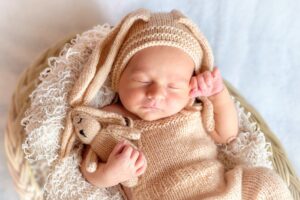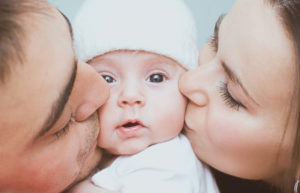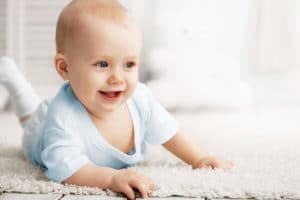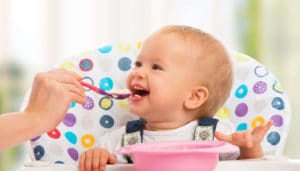A Baby’s body temperature can tell you something about whether your child is rested or tired, healthy or sick. How to deal with an elevated temperature in children, when a fever exists, and when a visit to the doctor makes sense, you can read now with us!
Table of contents
What The Body Temperature Of A Baby Tells You
The body temperature of your child can change again and again depending on the situation and condition. Babies and children have a fever much faster, higher, and more often than adults. Their bodies react to external influences such as activity and excitement, but also as a defensive reaction to pathogens.
Your baby can still regulate its body temperature poorly because its body surface is relatively large compared to its body weight. Babies therefore overheat or undercool more quickly than adults if they are dressed too warm or too cold.
What Is A Baby’s Normal Body Temperature?
A baby’s body temperature between 36.5 and 37.5 degrees Celsius is considered normal. With such a temperature, it can be assumed that your child is not feverish, but also not hypothermic. Within this range, the temperature can fluctuate throughout the day. In the evening, the body temperature is usually slightly elevated by 0.5 degrees, which can also be due to the evening bath or physical exhaustion. If your baby is rested and healthy in the morning, the body temperature will be in the normal range.
If your baby is very active during the day, wears headgear or clothing that is too warm, or sleeps under a blanket or sleeping bag that is too thick at night, the body temperature may also rise. In such cases, this rise in body temperature in the baby has nothing to do with fever. As soon as you remove the source of overheating, the baby’s body temperature usually drops quickly to a normal range.
You can easily check whether your baby’s temperature is comfortable by looking at the back of the baby’s neck. Simply place one or two fingers in this area: if the neck feels cold, hypothermia may be present. Cool hands, on the other hand, are not an indication that the environment is too cold. If, on the other hand, the neck feels sweaty, the baby’s body temperature may be too high.
When Is The Baby’s Body Temperature Elevated?
Babies and children are said to have an elevated temperature when it is between 37.6 and 38.4 degrees Celsius. An elevated body temperature can have many causes and does not necessarily indicate an illness. A visit to the pediatrician is not normally necessary if there are no significant symptoms other than the increased temperature. Many children do not notice such a body temperature during the day, while others feel tired and fatigued.
If your child has an elevated temperature, you should keep an eye on his or her general condition. Especially babies and small children need increased attention, activities and appointments should be limited. Quieter activities or even bed rest can help to lower the baby’s body temperature. With regular monitoring by taking a temperature and drinking plenty of fluids every half hour or so, you can treat your child’s elevated temperature well at home without the need for medication.
Fever – When The Body Temperature Continues To Rise
Many parents are concerned when their children have a fever. From when is a fever, what are the signs of a too high body temperature in the baby and when you should go to the doctor with a feverish child.
How Do You Recognize A Too High Body Temperature In The Baby?
Independently of the temperature measurement with the thermometer, there are also external signs that the baby’s body temperature is too high. In many children, the skin appears cool and pale, while the face appears hot and red. Tired eyes and an overall poorer-seeming condition may indicate that the baby’s normal or elevated body temperature has become a febrile temperature. If children are irritable and whine or refuse food, this may also indicate an illness.
But be careful – not all children react to a raised temperature with such signs. Some are quite robust and unchanged, which is why ultimately only a temperature measurement is really meaningful.
How To Take A Temperature?
To take the temperature easily and quickly, digital fever thermometers or those with infrared are recommended, which make it possible to take the temperature at the ear or forehead. This even works when the child is asleep and is completely painless.
However, since the skin temperature can deviate from the internal body temperature, doctors recommend rectal measurement for babies and toddlers for an accurate result. However, you should proceed very carefully and not insert the clinical thermometer too deeply. A little cream on the tip of the thermometer, a comfortable position of the child on the back or side and a toy to distract can make the measuring process more pleasant, especially for smaller children.
At What Point Is A Fever?
Babies and children are said to be feverish when their body temperature is 38.5 degrees Celsius and above. It can develop and rise quickly, especially in young children, which is why you should monitor your child more closely at such a temperature. In any case, bed rest is called for, perhaps your child would like to sleep more now anyway. Make sure that your child drinks tea or water regularly. You can now offer your baby breast milk or a bottle more often. Children who are already eating porridge or solid food are welcome to eat something when the temperature is high if they are hungry. Easily digestible foods such as soups or softly cooked, non-bloating vegetables are recommended at this time. However, it is more important that your child drinks.
In case of fever, the baby’s body temperature should always be checked. If you want to give fever-reducing suppositories or juice, it is best to consult your pediatrician.
Newborns Already Have Fever From 38.0 Degrees
It is important to know that babies up to three months of age already have a fever at a lower temperature: 38.0 degrees. Many younger babies have not yet fully developed the ability to fever, so that even with a normal or slightly elevated body temperature in the baby, an infection may be present. Therefore, pay particular attention to how your baby behaves, whether it seems unusually weak or listless, drinks poorly or shows colorful skin changes. If you notice any of these signs, you should consult a pediatrician as soon as possible!
At What Point Is A High Fever?
When children have a high fever, they have a body temperature of 39.0 degrees Celsius or more. In such a case, the same recommendations apply to moderate fever. You can also make sure that your child is not wrapped up too warmly in bed. Otherwise, this could lead to a further rise in temperature. If the child sweats when he has a fever, change his underwear regularly. Many small patients benefit from a cool cloth on the forehead, in other cases, calf compresses can also bring relief. In the case of chills, on the other hand, a warm blanket is good. If the baby or child’s body temperature is too high and the symptoms persist for a long time, medical advice may be helpful.
When To See A Doctor For Fever
When you should take a child with a fever to the doctor also depends on the child’s age. But some symptoms and complaints also indicate that a visit to the doctor is necessary.
When to go to the pediatrician with a fever?
- When the baby is three months and younger.
- If there is a fever for more than one day (babies older than 3 months, infants younger than 2 years).
- If there is a fever for more than three days (children 2 years and older).
- If there is abdominal pain, vomiting, and/or diarrhea.
- In case of chills, febrile convulsion, or other, unclear symptoms.
- In case of recurring fever.
- If the fever does not go down despite medication.
- If the child is not drinking enough fluids.
What Is 3-day Fever?
3-Day Fever is a typical febrile illness that affects many children once in the first three years of life. As a viral infection, it causes a high, feverish body temperature in the baby or child that lasts for three to four days. Once the temperature has dropped, a widespread rash develops on the chest and back that can continue to spread. While some of the little patients with 3-day fever are very fatigued, in others it occurs in a weakened form. The baby’s body temperature then does not rise as high, and the general condition remains good despite the illness.
The cause of 3-day fever cannot be treated with medication, but fever-reducing measures can be taken against an excessively high body temperature in the baby. Once the disease is contracted, it produces lifelong immunity.











4 thoughts on “Body Temperature In Babies: When Is It A Fever?”